Solana Blockchain - Crypto Academy / S4W4 - Homework post for pelon53 by @azissuloh

Solana Blockchain is one of the many crypto projects that provide the best decentralized financial services. Although many other projects have almost the same ideas and goals as Solana, The way the Solana blockchain works is very different from the others. Solana has the advantage of speed in making transactions.
The Solana blockchain project has been launching its whitepaper since 2017. The Solana platform was released by Anatoly Yakovenko, who previously worked at the Qualcomm company. The Solana Foundation was founded in April 2020. The Foundation now owns all intellectual property and rights owned by Solana Labs. Solana blockchain is considered to be one of the fastest blockchains in the crypto world. Solana aims to accelerate and multiply transactions that occur on the blockchain. To realize this, they use the latest technology. This assumption is not an exaggeration, because Solana is a web-scale blockchain providing marketplace services and secure, fast, easy decentralized applications.
Solana uses the Proof of History (PoH) consensus. This Consensus Proof of History can allow every transaction to be able to create a history useful as a record of evidence of an event over a certain period of time. Furthermore, Solana blockchain uses an Algorithm in PoH consensus, The algorithm is a Verifiable Delay Function which can be verified with high frequency. This algorithm requires a certain number of steps to be evaluated.
Transactions that have been verified earlier, will later be given a unique hash so that the calculation results can be verified effectively and open to the public. This calculation allows users to know the history of every transaction that occurs on the Solana network and functions like a cryptographic timestamp.
How does PoH work
Solana's system is currently capable of supporting 65,000 transactions per second and 400ms Block Times. Of course this is because with Solana's original purpose which I have discussed, and supported by the use of technology and innovation. Among the innovations in the Solana blockchain are Proof of History, Pipeline, Tower BFT, and also GULF Stream.
PoH (Proof of History) works by running the SHA256 function (hash function) continuously. The output generated from that function, will then be the input for the next function to form a Hash chain. To help optimize consistency in reading data, then PoH will add important data before consensus This is because sequences, and timestamps can be validated without continuous direct monitoring, and also without interacting directly with each node. In addition, PoH will also synchronize PoH with each other automatically.
Proof of History also has a function for the BFT tower as its cryptographic clock. The benefit of this function is that it will allow consensus to be reached without the expense of message transfer fees, and also high transaction latency. The BFT tower itself can simplify the performance of the PoH consensus.
For more clarity and detail, Proof of History will create a long chain, and will not be interrupted through the hashsing process that I wrote above. this process will result in transactions that are neatly sequenced, and clearly verified. Next, it will be added to the block by the selected validator without the need for conventional timestamps, After that, hashing will work by taking some time to complete, so that the validator can verify the length of time it took for the hash to have been processed and passed very easily.
- MERCURIAL FINANCE

Screenshots in this section are from
Mercurial finance is one of the defi-based insurance platforms and is also the first project to be successfully built on the Solana ecosystem. Mercurial itself is built on Solana as a result of its high performance and strong network potential. This network provides vaults, defi pools as a repository for stable coins owned by users. They also have technical tools that allow users to deposit and mint their stable coins easily.
Currently mercurial is supported by several organizations, including Solana ecosystem, OkEx, Nano, Coinecko, Blockfolio, and many other organizations. Transactions in this network will be facilitated by Solana's strong performance.
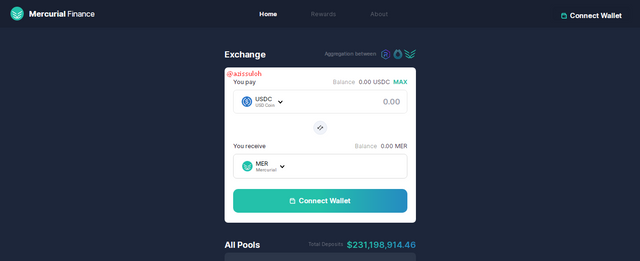
Interface of mercurial finance
When users place their assets on the mercurial platform, they can generate some liquidity. Assets on the platform are open to multiple use cases These include loans, low slip swabs, decentralized protocols, and express loans. MER is the original token of mercurial finance, when I wrote this review, MER is trading at around $0.4841 with a market cap of $487,813,364, and is ranked 3210 on coinmarketcap.
- ORCA

Screenshots in this section are from
For the second is ORCA, it is a project built on the Solana blockchain network. To use this platform, The user must first connect the Sollet wallet, or any other wallet of choice. Orca is a DEX platform that is very easy to use, and the costs there are very low. In addition, not only DEX, Orca is also included in several other categories such as AMM, DeFi, DAO, and also Yield Farming.

Screenshots in this section from
Orca has a native token, the name of the native token is the same as the name of the platform, namely the orca token. Orca tokens are created with smart contracts from the Solana blockchain. This makes it very fast, and scalable when users make transactions. The Orca token is currently trading at a price of $15.19 and there is a possibility that it will continue to creep up. Launching coinmarketcap, orca token is ranked 2756.
On the orca platform, we can also trade with many other coins. There are at least about 35 cryptos there, and we can exchange all those coins. Apart from making exchanges, we can also stake, and jump into the pool. In essence, the orca platform is very simple, so it is easy for us to operate.

Screenshots in this section from
SOLA token is a Defi built on the Solana network, and combines the functionality of a DEX (Decentralized) exchange with a (CEX) centralized exchange. The sola token also offers a liquidity pool and uses AMM. AMM is the main algorithm currently used by most of the decentralized exchanges of liquidity pools.
Sola Token has also partnered with Solana-based DEX, serum and order book features used in Serum have been integrated into the Sola token exchange. Even though the platform is not currently fully operational, they have listed a number of crypto assets on the network all of which are traded with USDC. Apart from that they can also be traded on the platform.
Sola token also has a native token named SOLA. SOLA is what will be used to develop the network. SOLA's initial supply of around 27 million distributed by airdrops, and others for trading, and platform liquidity providers.
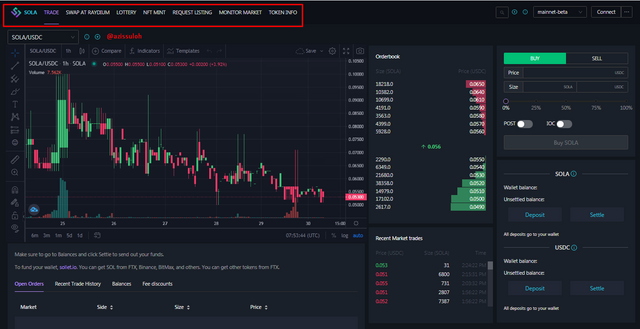
Screenshots in this section from
When the Sola token is fully operational, we as users can exchange, trade tokens, print NFT, do the lottery, and can also stake. Below is detailed information about sola token, I took this information from coingecko based on the time when writing this review.
- Rating: 1886
- Circulating supply : 27,153,077
- Maximum supply : 27,153,077
- Price : $0.051919
- Marketcaps : $1,409,756
- Transaction volume in 24 hours : $45,028

Screenshots in this section are from.
The Solana Blockchain Network crashed on September 14th. This incident brought the entire blockchain network to a complete standstill for almost a day. Due to the shutdown of the main network, all other projects using smart contracts from Solana also experienced the same thing. This tragedy occurred when the SOL token strengthened which caused its price to skyrocket, in early january it was only around $2, and it's over $200 this month. This performance then becomes the attention of investors. so this incident is believed to cause data overload on validator nodes when bulk transactions are performed.
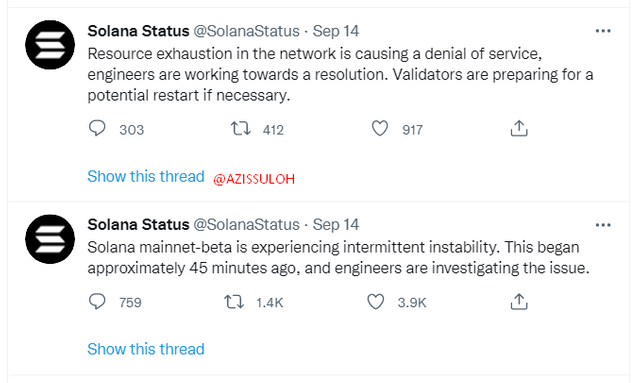
Screenshots in this section are from
According to the information provided by the Solana team, the death of the Solana Blockchain network was due to the large number of transaction flows occurring at the same time,
causing Solana's network to be completely paralyzed. The team suspects this is due to bots making solana transactions go up to 400,000 per second. The number of transactions that reach up to 400,000 per second, clearly a transaction that exceeds Solana's capacity, Please note that currently Solana is only able to accommodate about 65,000 transactions per second.

Screenshots in this section are from
Other information from the founder of Solana via his tweet conveys that. The denial of service has occurred due to transactions generated by bots during the launch of the IDO Grape Protocol on Solana's Raydium based platform. its occurrence, in addition to mass transactions on the network, has resulted in disruption.
As a result of this incident, a hard fork was proposed by the Solana community. However, this proposal must be approved first. After the proposal was approved by 80% of active stakeholders, a consensus was reached to continue the hard fork. Furthermore, the network returned to normal in just 2 hours after the hard fork was done.
The original Solana SOL token is currently trading at around $130, which is about 17% down from its price on September 14th. the effect is not as extreme on the main token of the network as expected, but on some other projects running on the network negatively affected by this Incident.

Screenshots in this section are from
To view the last block of Solana Blockchain I access Solanabeach.io, what I saw there was something extraordinary. Because, in just seconds, Solana blockchain is capable of generating multiple blocks. To be clear, I will dig deeper information about how many blocks can be generated in one second. Because if you only see the display above, of course it will be difficult to get information.
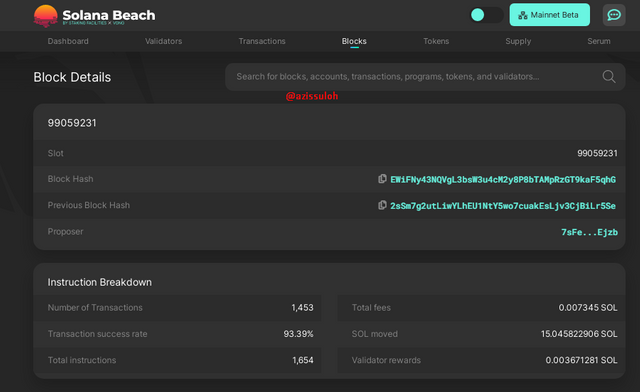
Screenshots in this section are from
The last block I saw was 99059231 and there are around 1453 total transactions processed in the block with a transaction success rate of around 93.39%. This means that there are around 1357 transactions that have been successfully executed. If we use Solscan.io, we can see a very clear timestamp for block 99059231, see image below.
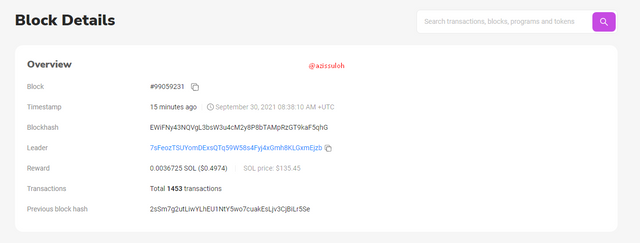
Screenshots in this section are from
however, when I check the details of block 1, there can't see any time.
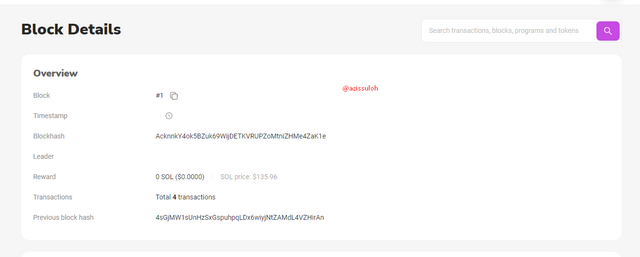
Screenshots in this section are from
Now let's try to calculate how many blocks Solana Blockchain can generate per second, per hour, per day and per year.
According to the information provided by Team Solana that the Solana Blockchain Network is capable of generating 1 block per 0.5 second. The current block is 9905923, if we multiply by 0.5 (0.5x9905923) then the result is 49529615s, now let's check from seconds to years.
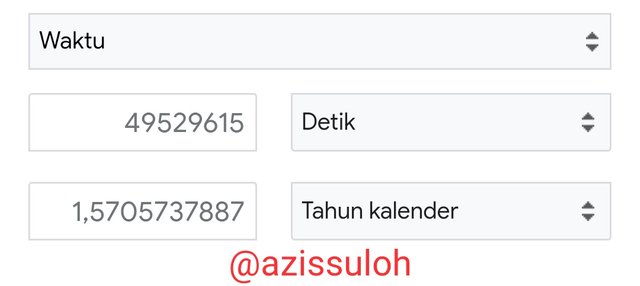
Then the result is 1.5705737887, meaning it tells us that the time spent producing the current block is 1.5 years. although exactly 18 months since Solana Blockchain started operating in March 2020. Based on the results of this excavation, we can conclude that Solana Blockchain is capable of generating 1 block every 0.5 seconds.
This means that this is in accordance with what the sola team has informed that the Solana blockchain network can generate 1 block per 0.5 second. the following is the calculation of the block in seconds, up to the year. 1 block - Per 0.5 seconds, 120 blocks - Per 1minute, 7,200 blocks - Per 1 hour, 172,800 blocks - per 24 hours, 5,184,000 blocks - per 1 month, 62,208,000 blocks - per 1 year
Solana blockchain has proven to be a strong blockchain and many projects built on the Solana network are running well on the blockchain. More than that Solana Blockchain is a very good and fastest blockchain in the world, this is the result of the hard work of the developers and the Question team being able to develop a blockchain that is very unique and different from the rest. In exploring Sola Token, I realized that it is an amazing platform, which not many people know about.